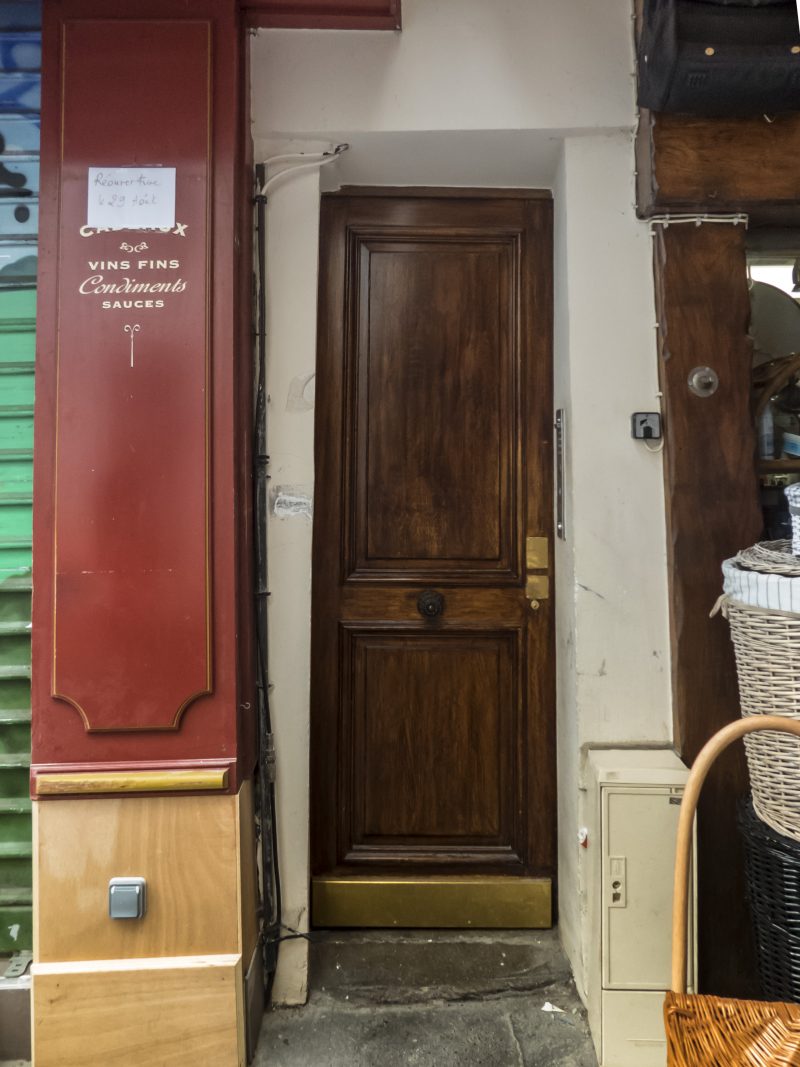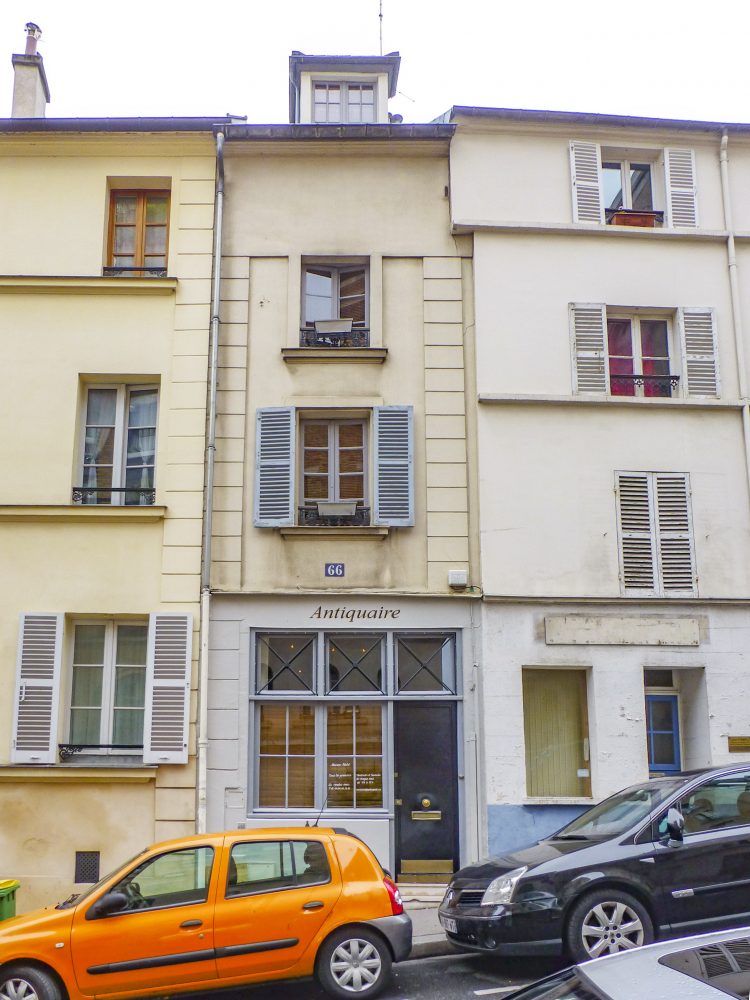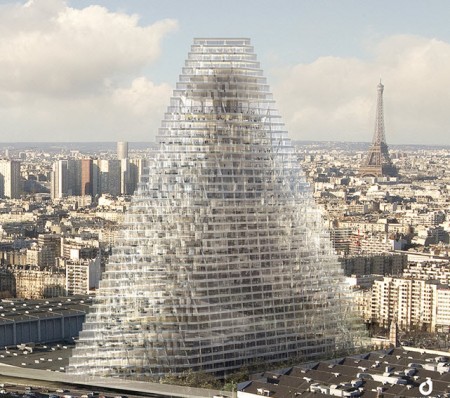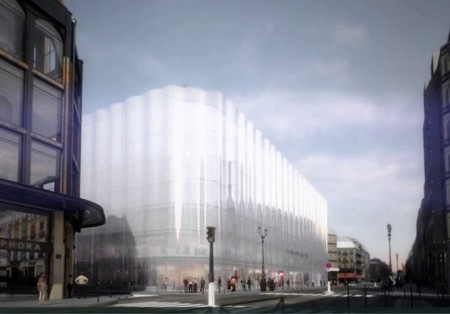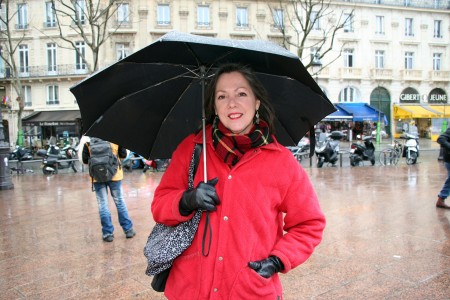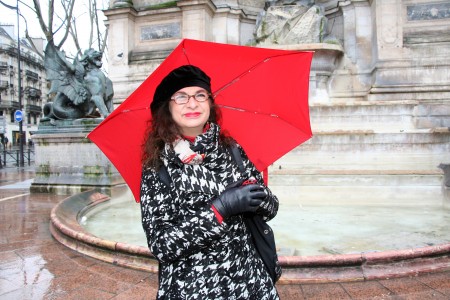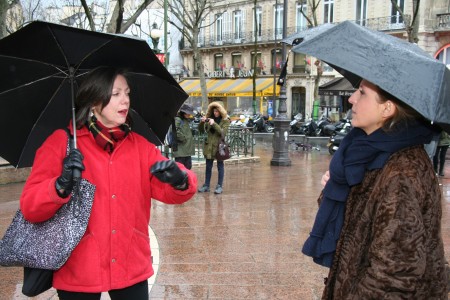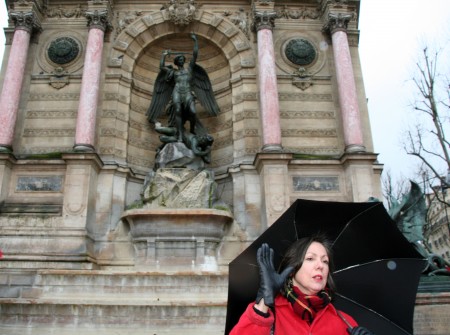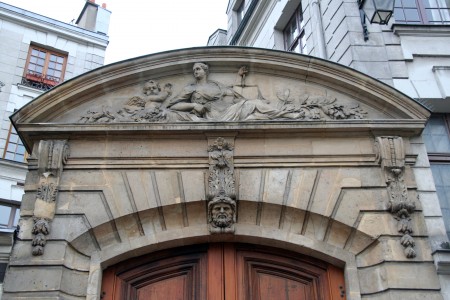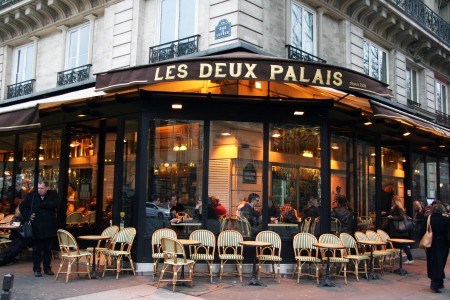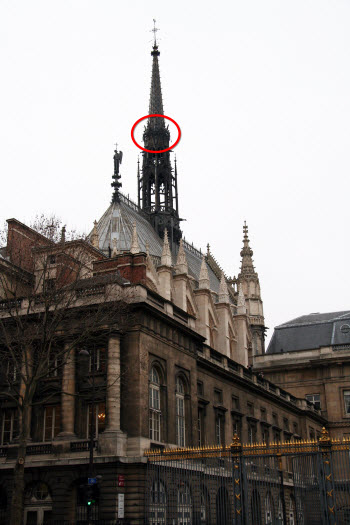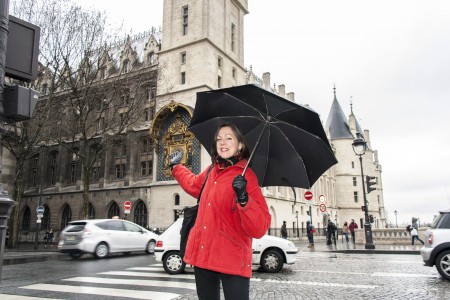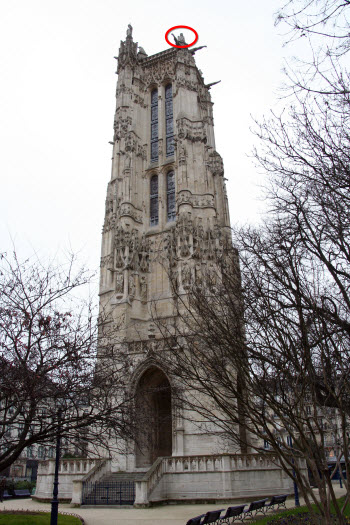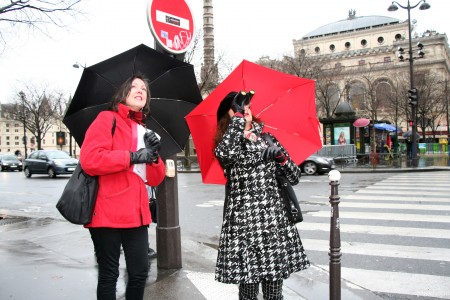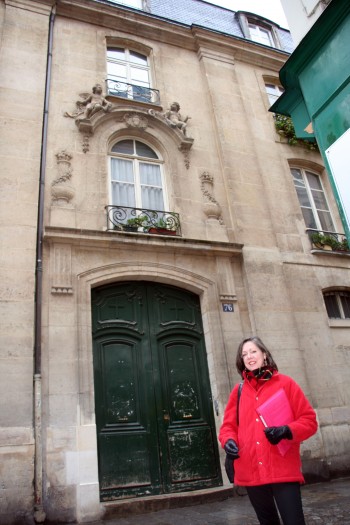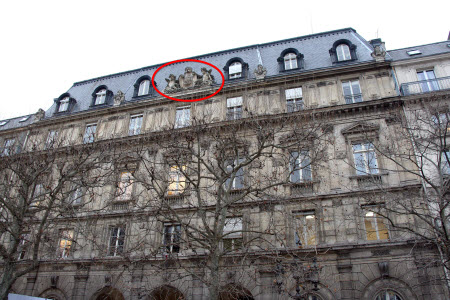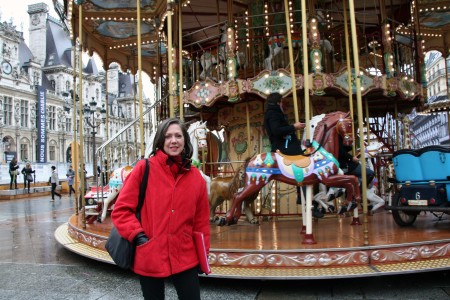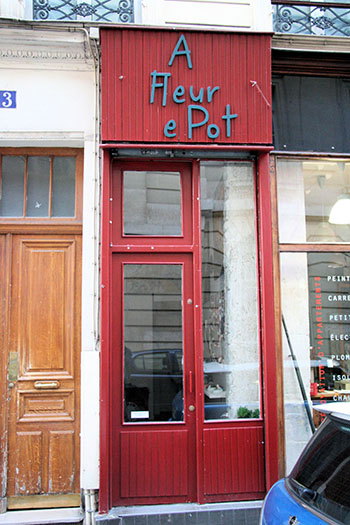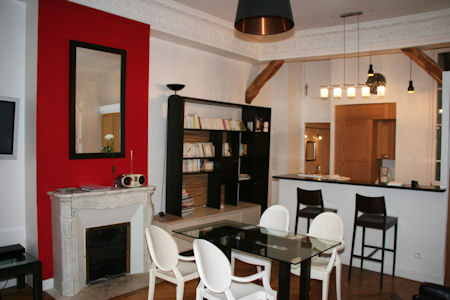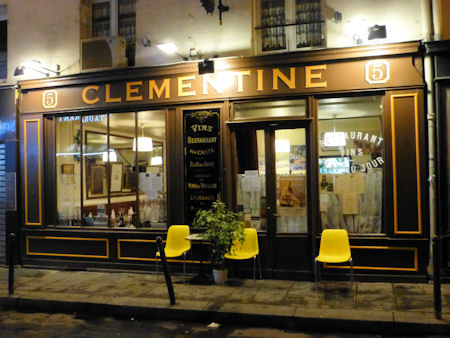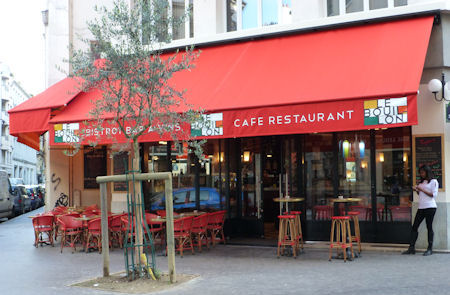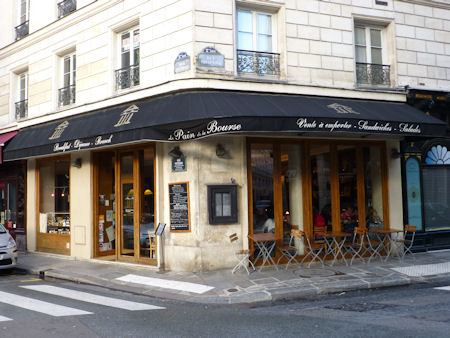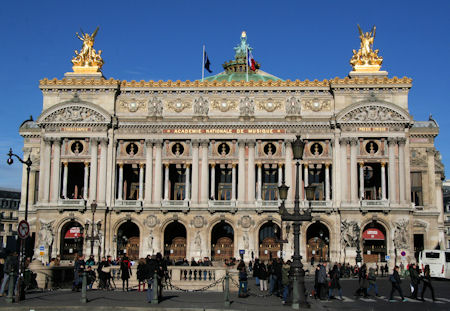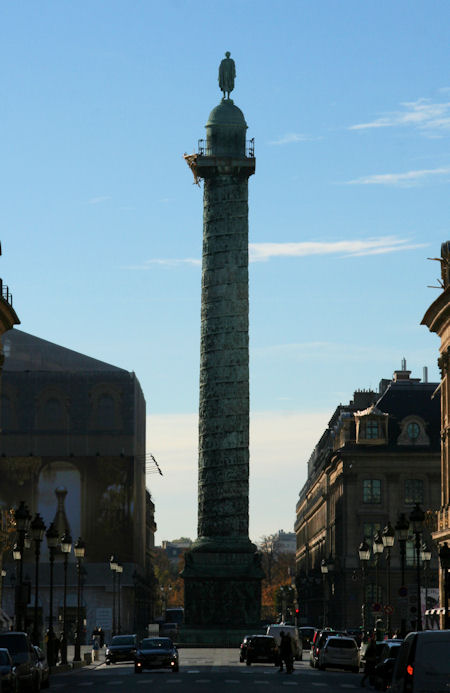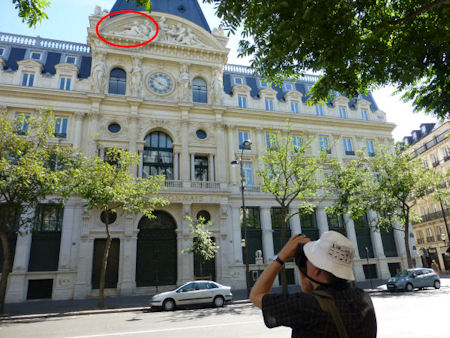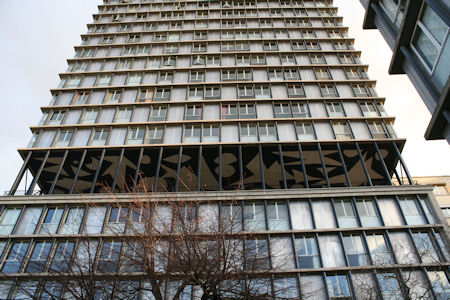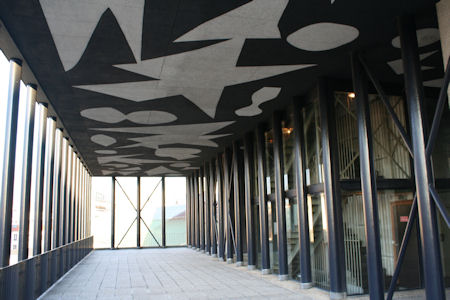This door, located at 133, rue Mouffetard, is only 27-1/4″ wide (69.22 cm). Can it be the narrowest in all of Paris?
Archive for the ‘architecture’ Category
Is This the Narrowest Entryway in Paris?
Saturday, August 19th, 2017Narrowest Apartment in Paris?
Monday, July 24th, 2017Spotted on rue Lhomond in the 5th arrondissement. – Could this be the narrowest apartment in #Paris?
Henri Sauvage’s Stepped-terrace Apartment Building
Thursday, December 17th, 2015This stepped-terrace apartment building by architect Henri Sauvage (1873-1932) stands at 26, rue Vavin. It was constructed in 1912-1914.
Stepped terraces are not the only unusual feature of this building. Sauvage chose to cover the façade with white, glazed stoneware tiles, the material that is commonly used for the walls of most metro stations in Paris, because of the ease with which it can be washed. The use of these tiles fulfilled Sauvage’s concern for hygiene, which was a widespread social concern at the time. The tiles can also be seen as a manifestation of his desire to make a break with the past — a declaration of architectural modernity.
Sauvage built another stepped-terrace building at 13, rue des Amiraux in the 18th arrondissement.
Paris, The End Days by Leonard Pitt ©2015
Monday, August 24th, 2015
The question today is, “What will Paris look like a hundred years from now?” Recent developments answer the question.
Central Paris, preserved in its beauty, will sit at the bottom of a bucket surrounded by skyscrapers. The tourist driving into the city will pass signs along the way with arrows pointing towards “Centre Historique.”
Sound far fetched? Sadly not. How many Americans know of Mayor Anne Hidalgo’s plan to transform the city? Fearful that her capital is old fashioned and fast becoming a museum-city paralyzed in its beauty, she has embarked on a vast program dubbed Reinventing Paris to make her capital a showcase for futuristic architecture. And this includes building skyscrapers.
The reader gasps. “Skyscrapers in Paris! Are they crazy? Isn’t that why they built La Defense?” Right on both counts. But La Defense (the business district built to the west of the city) never lived up to expectations. So what they built outside of Paris and didn’t work, they now want to build inside Paris thinking (hoping) it will work.
Inconceivable as it may seem, the French think that skyscrapers will make the city more attractive and draw world-class corporations to restart a flagging economy.
I have news for Madame le Mayor. It won’t work.
But wait, it gets worse.
Paris is not stuck only on big modern. Small will do as well. The former department store La Samaritaine, comprised of several buildings between the Seine and rue de Rivoli, was closed in 2001 and sold in 2005 to the luxury group LVMH (Louis Vuitton, Moët-Hennessey). The plan is to convert the entire site into a four-star hotel and many floors of high-end shopping for the 1% tourist trade. To mark this rebirth, a “strong architectural gesture” was desired for the rue de Rivoli side.
The Japanese design group Sanaa was brought in. It designed a building with a seven-story facade of undulating glass extending the entire length of the block. The proposal was dubbed the “shower curtain” by protest groups who filed lawsuits to stop the project.
While litigation moved through the courts, four buildings were torn down: three built in 1852, and one in 1740. Then came the judgment: building permit annulled! All work was halted. A tad late for historic Paris.
The Paris City Plan, it was pointed out, states that new construction in Paris must not rupture the existing urban fabric. Supporters of the glass facade argued there would be no rupture. The glass would reflect the Haussmann buildings across the street. LVMH filed an appeal. The Mayor, horrified at the annulment, did not hesitate to put pressure in the right places and months later the court fulfilled her heart’s desire. Decision reversed. Paris will have its shower curtain after all.
To ensure that a boondoggle of this sort doesn’t happen again, Mayor Hidalgo has since proposed changes to the Paris City Plan to give wider berth to her plans to build modern and tall in Paris.
Once completed, the new Samaritaine facade will surely have a luster of newness. But it won’t last. It can’t last. Like Les Halles before it, this stretch of rue de Rivoli is destined to become the site of future regret in Paris. Sure as gravity.
A majority of Parisians are against this foisting of a modernity on Paris that can only fail. It is remarkable that citizens don’t amass by the thousands in front of City Hall to protect their jewel and stop it from becoming Dubai West.
Modernity has always had a hard time in Paris. The conversion of the old central market, Les Halles, the 59-story Maine-Montparnasse tower, and the mini-Manhattan within view of the Eiffel Tower (known as the Front de Seine) are all admitted failures. Each project in its turn showed Paris to be a living organism. The attempt to graft did not take. The host rejected the foreign body.
Paris will always be ready for the Rick Steves photo op. Tourists will continue to flock and will find plenty to love. But as that subtle membrane containing the city in its most delicate aspects – the low Paris skyline – is punctured by skyscrapers and the historic fabric of the city is ripped by an inappropriate modernity, one day the experienced Paris visitor will walk down a familiar boulevard and remark how everything in the beloved city looks the same but, oh, how different it all feels.
Did someone say, “We’ll always have Paris?” Hmmm . . .
Leonard Pitt is an author, actor, and teacher. He lived in Paris for seven years in the 1960s and knew nothing about the city. It was only much later, in the 1990s, when he was so shocked at what he finally learned that he did not know that he started reading and researching everything he could about Paris and its history. And as someone once said, “If you want to learn about something, write a book about it.” Leonard has written three books about Paris. His first, Walks Through Lost Paris was a bestseller in the City of Light. In addition he has written, Paris, A Journey Through Time, and Paris Postcards, the Golden Age. He has a new book due out later this year, a memoir, My Brain On Fire, Paris and Other Obsessions by Counterpoint Press.
Angels of Paris – A Guided Walking Tour with Rosemary Flannery
Tuesday, February 17th, 2015When Rosemary Flannery invited me to join her for a guided walking tour to see the angels of Paris, I jumped at the chance. Rosemary is an expert on angels, having published a book on the subject.
The rendezvous point was set for place Saint-Michel, a popular square on the river between quai Saint-Michel and quai des Grands Augustins. The day was cold and drizzly, but the rain didn’t come down hard enough to keep me away. Nor did it chase away other people who gathered there for one reason or another. Soon the square was abuzz with different groups milling about.
Rosemary showed up, looking lovely in her red jacket.
Adrian Leeds showed up carrying a red umbrella. No shrinking violet she! A woman who wears many hats, including the beret that she dons for style and for warmth, she is president of The Adrian Leeds Group.
Another person showed up (on the right in the photo above), but she had to dash off soon after. That left us as a group of three, Rosemary, Adrian, and me.
Rosemary talked about Michel, the Archangel who defeated Lucifer in a mighty battle and cast him out of Heaven. Attached to Michel’s back are enormous wings befitting a powerful angel, while Lucifer displays only tiny bat-like wings affixed to his shoulder blades. The sculptural group by Francisque Duret was created to embellish this square, which was built by architect Gabriel Davioud in 1860 during the era of Baron Haussmann’s renovation of Paris.
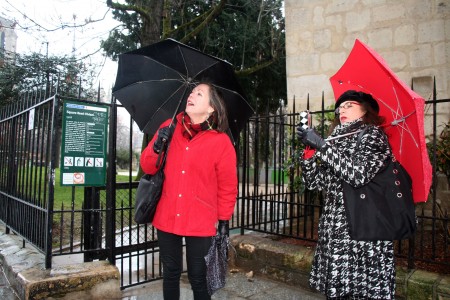
Rosemary and Adrian Admire Angel on the Doorway to the House of Isaac de Laffemans
Photograph by www.DiscoverParis.net
Our next stop was on rue Saint-Julien-le-Pauvre, where we admired the pediment over the entrance to the house of Isaac de Laffemans. One of the most despised public figures of the 17th century, de Laffemans served as the Civil and Criminal Lieutenant of the Provost of Paris, administering “justice” to the enemies of anyone suspected of plotting against Louis XIII. The pediment displays a chubby angel and a lounging woman in a low-cut gown, who swings the scales of justice to and fro, apparently with the same insouciance that de Laffemans had for his victims.
We were feeling chilled, so we stopped for hot chocolate at Les Deux Palais, a café across the street from the Palace of Justice. While we warmed up, Rosemary talked about the angels of the spire of Sainte-Chapelle, a 13th-century gem of a church that stands next to the palace. She explained that there are eight angels, four of which hold instruments of the Passion. They are interspersed with four angel musicians blowing long trumpets.
We left the café and stopped just a block away to admire the Tour de l’Horloge. Constructed in the 14th century at the behest of Charles V, the face of the clock displays a duo of angels bearing the royal shield.
At the corner of avenue de Victoria and boulevard de Sébastopol, we looked up to see the Tower of Saint-Jacques rising high above. Rosemary pointed out an angel who represents Matthew, one of the four evangelists of the New Testament. The tower was built as a bell tower for a church named Église Saint-Jacques-de-la-Boucherie, whose parishioners were the butchers of the central market place that once existed nearby. The church was dismantled during the Revolution, but somehow its tower was preserved. Today it soars gracefully into the Paris sky!
Rue de la Verrerie was our penultimate stop. Rosemary called our attention to two angels sitting on the molding of the façade of the Saint Merry Church presbytery. Merry, a nickname for Medericus, was a 7th century abbot who came to Paris to live as a hermit. Somehow, he got a church named after him. The angel on the left clutches a giant pair of keys in tribute to Peter, gatekeeper of Heaven, while the other holds an abbot’s staff. Between the angels, just below the molding, is a heart, an allusion to Medericus’s heart that was once conserved as a relic here until it disappeared during the Revolution.
From rue de la Verrerie, we walked over to place de l’Hôtel de Ville where Rosemary pointed out a duo of mischievous-looking angels with fetching smiles posed above the sober facade of an administrative building. Between them, the angels present the Seal of Paris: a three-masted galleon floating along the wavy currents of the Seine. A patterned strip of fleur-de-lis decorates the top, while the shield is crowned by a circle of crenelated towers, evoking the medieval ring of fortifications that once surrounded the city.
Rosemary was eager to show us other angels, but we had run out of time. It had been a fascinating morning learning about the angels of Paris!
Rosemary Flannery offers guided tours of Paris. Information about her services can be found at the following link: http://passport-to-paris.com/.
One of the Narrowest Shops in Paris
Saturday, June 21st, 2014This shop, measuring 1.1 meters wide, stands at 3, rue Clotaire in the 5th arrondissement. The sign above the door indicates that it used to be a flower shop, but it is now an art gallery called Galerie Rouleau. But the gallery won’t be at this location much longer, because the proprietor, Ying na Zhao, told me that it will move at the end of June to a larger location.
The gallery exhibits paintings, ceramic jewelery, and photographs from China.
I look forward to visiting the gallery at its new location so that I can step back to admire the paintings!
44 rue Vivienne
Part III – The Neighborhood
Thursday, November 14th, 2013
Last weekend we had the opportunity to stay in an apartment that was loaned to us by Habitat Parisien. It is located near the Bourse in the 2nd arrondissement, an area that doesn’t seem to be on too many travelers’ radar. This gave us the occasion to explore a neighborhood with which we had previously only been scarcely acquainted.
We arrived at the rue Vivienne apartment at 5:00 p.m. and checked in. At 7:30 p.m., we headed to a bistrot called Restaurant Clémentine that is located only one block away on rue Saint-Marc. (Read our review at the following link: Paris Insights – The Restaurant Review.) In its old-fashioned setting (the restaurant was founded in 1906) we had a fine, modern meal. The food wasn’t the heavy cuisine that is often associated with bistrots. If the evening we spent there had been the only thing we did that weekend, it would have been worth it!
After dinner, we wandered around the neighborhood and spotted a lively café called Le Bouillon on the corner of rue Saint-Marc and rue Vivienne. A lot of customers were sitting on the terrace drinking cocktails and I noticed that Irish coffee was on the happy-hour beverage menu. We decided to return there in the morning for breakfast. On our way back to the apartment we passed by Lefty, a burger restaurant that bills itself as an “American bistro.” The bartenders were cordial as they handed us a business card, but we didn’t return to try their fare.
In the morning, we returned to Le Bouillon for a fixed-price breakfast consisting of a demi-baguette split in half, butter, jam, a glass of orange juice, a hot beverage, and a bowl of scrambled “eggs” with “cheese.” The eggs were not moist and soft as we had anticipated, but were rather dry and grainy. They appeared to have been reconstituted from a powder because they did not have true egg flavor or texture. The cheese (which I could barely taste) in the eggs must have contained a lot of salt, because we were quite thirsty for the rest of the day. The orange juice tasted as if it had been made from concentrate and the hot chocolate that Monique ordered was thin and flavorless. My café crème was adequate, but I was surprised that I couldn’t find it listed as one of the beverage choices for the fixed-price breakfast. It was served as a courtesy, in place of the double espresso that was listed there. Why the management didn’t offer the choice of a café crème on this menu was beyond my comprehension.
Happily, our disappointing meal at Le Bouillon was easily forgotten the following day when we had breakfast at Le Pain de la Bourse, a restaurant only a block away. For details about the breakfast, read my review in Paris Insights – The Restaurant Review.
On Saturday, we strolled through the neighborhood and spotted a number of noteworthy sights.
First, there is the Bourse, the former stock exchange designed by Alexandre-Théodore Brongniart and constructed from 1808 to 1826. Two wings were added in 1902 and 1907. No longer the home of the stock exchange, the building is now called Palais Brongniart and is used as a conference and event center.
Nearby we came upon a columned street called, appropriately enough, “rue des Colonnes.” In close proximity stands a sign that indicates that the street is one of the rare examples of construction that took place during the Revolution.
The area is famous for its covered passages built in the 19th century. We came upon the Passage des Panoramas, and across boulevard Montmartre, spotted the entrance to Passage Jouffroy. Next door to this latter passage stands the famous wax museum, Musée Grevin, opened in 1882.
Walking west along rue du 4 Septembre, we came upon the opulent Opéra Garnier, built from 1861 to 1875.
Looking south into the 1st arrondissement we could see Place Vendôme with its majestic Vendôme Column, surmounted by a statue of Napoleon I.
From avenue de l’Opéra, we caught a bus back to our apartment in the 5th arrondissement, ending our weekend adventure in the historic 2nd.
If there is one thing that we learned from our stay in the apartment on rue Vivienne, it is that there is a lot to explore in the area around the Bourse!
Like our blog? Join us on Facebook!
The Eternal Quest for Beautiful Fesses – Our Fesses of the Month
Tuesday, November 5th, 2013We found this month’s featured fanny on a pediment high above boulevard des Italiens in the 2nd arrondissement. The allegorical figure to whom these fesses belong is part of a group sculpted by Camille Lefèvre in 1880-1883.
Follow the link below for a close-up view!
pinterest.com/pin/411586853416461175/
Like our blog? Join us on Facebook!

